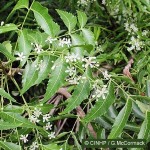Cook Islands Biodiversity Database
Species Page
Azadirachta indica
Neem Tree
Multimedia & Additional Resources
| Type | Description | Download |
| Leaves and flowers | 80KB |
General Information
Cook Islands Distribution
| Southern Group: - Makatea: - | ||||||||
RR |
MG |
AT |
MK |
MT |
AK |
PL |
TK |
MN |
+ |
- |
- |
- |
- |
- |
- |
- |
- |
| Northern Group: - | |||||
TN |
MH |
RK |
PK |
NS |
SW |
- |
- |
- |
- |
- |
- |
Scientific Taxonomy
Azadirachta indica A. Juss
SYNONYMS: Melia azadirachta
TAXONOMY: PLANTAE; ANTHOPHYTA (=Angiospermae); MAGNOLIOPSIDA (=Dicotyledones); ROSIDAE; Sapindales; MELIACEAE
More Information
GENERAL NOTE: Many uses. Earliest reference to it is in Sanskrit writings that are over 4,000 years old. Parts of this tree have been used for medicine, shade, building materials, fuel, lubrication, and as an insecticide. Mature at 3-5 years, and fully reproductive at 10 years, and can live to 200 years. Typically the 20kg of fruit contains about 2kg of seed kernel, and this contains about 20grams of insecticide extract, mostly a complex of chemicals called Azadirachtin. It is extracted by leaching with water, or with nonpolar solvents. In rural India the Neem is called the "village pharmacy" because it "cures" diseases and disorders ranging from bad teeth and bedbugs to ulcers and malaria. The seeds, bark and leaves contain compounds (called limonoids) with antiseptic, antiviral, antipyretic (=reduce fevers), anti-inflammatory, anti-ulcer and antifungal uses. Neem extracts contain various insecticidal and insect-repelling chemicals: (a) it has been approved by the US EPA for use on food crops, and is non-toxic to birds, beneficial insects and mammals (including people); (b) it is effective against head lice and scabies; (c) one chemical is a more effective insect-repellant than DEET. One extract is toxic to resistant strains of malaria; another extract is toxic to several fungi including those causing athlete's foot, ringworm, and thrush (Candida); another extract can prevent tooth decay and periodontal disease; another extract is toxic to the herpes virus and cures cold sores; and extracts have had encouraging results in AIDS prevention and a possible cure. On the side extracts can increase the immune response thus reducing cancers and tumours;reduces allergic reactions; the oil can prevent pregnancy; extracts reduced fertility in male monkeys without inhibiting libido or sperm production, making it potentially the first male birth control pill; can reduce heart attacks and reduce high blood pressure.
Vouchers & References
Vouchers:
None Recorded.
References:
p.492 Neal - In Gardens of Hawaii
p.3/530 A.C.Smith - Flora Vitiensis Nova
Data Update History (information):
zTX, zB02, zM04b, Zd02
Web Resources
Citation Information
McCormack, Gerald (2007) Cook Islands Biodiversity Database, Version 2007.2. Cook Islands Natural Heritage Trust, Rarotonga. Online at http://cookislands.bishopmuseum.org. ![]()
Please refer to our use policy.

